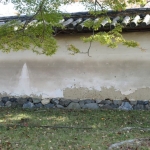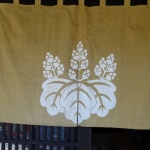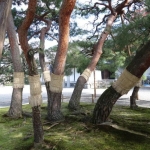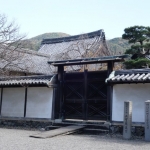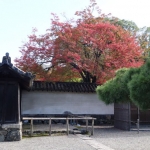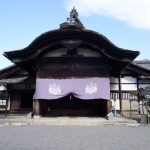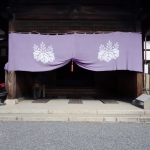Sambo-in
The wren
Earns his living
Noiselessly.
–Issa
This sub-temple garden is within the Daigo-ji complex and quite different from most temples and gardens. It is definitely worth visiting, even if no photography is allowed. In addition to viewing the garden, it provides the opportunity to walk on tatami mats viewing the elaborate paintings of the interior.
In the late sixteenth century the languishing temple was restored by Toyotomi Hideyoshi. He lavished particular attention on Sanbo-in, ordering construction of an unusual garden based around a pond which used kare sansui (dry landscape) techniques. Boulders were brought from around Japan, some with a unique history, and arranged with precise care.
A remarkable feature of the garden is the placement of a large rectangular stone, set into the background of the composition, known as the ‘Fujito stone’. The stone, one of the first to be brought to the garden, was purchased by Hideyoshi for the vast sum of 1000 koku of rice. A koku being sufficient rice to keep a man alive for one year.
Although the other buildings at Daigo-ji maintain a more orthodox religious atmosphere, Hideoyoshi created this sub-temple to accommodate more secular pursuits, such a viewing Daigo-ji’s famous cherry blossoms and tea parties. The opulent interiors suggest more villa than temple.
Hideyoshi was never to see the garden completed, as he fell ill and died in the early autumn of the year following the great cherry party. His gardener Yoshiro continued to work over the design of the garden until its eventual completion in 1618. The garden was duly hailed as a masterpiece and Yoshiro was given the honorary title of ‘Kentei’, meaning “Excellent Gardener”. The garden reflects well the personalities and temper of the particular period, which was very much one of extravagant display, and richness. Not a period of simplicity and restraint the period was a very much a reflection of the tastes of the character who dominated the times.
One of Samboin’s most interesting features is the large wooden gate called the Chokushimon, viewed from the outside grounds. On it two huge imperial chrysanthemum crests are arranged side by side with two of Hideoyoshi’s paulownia-leaf crests.


